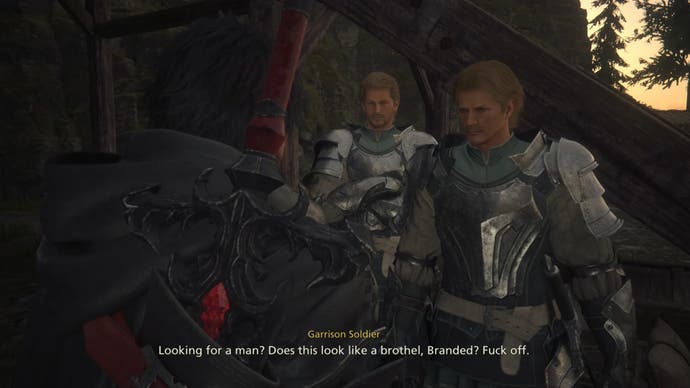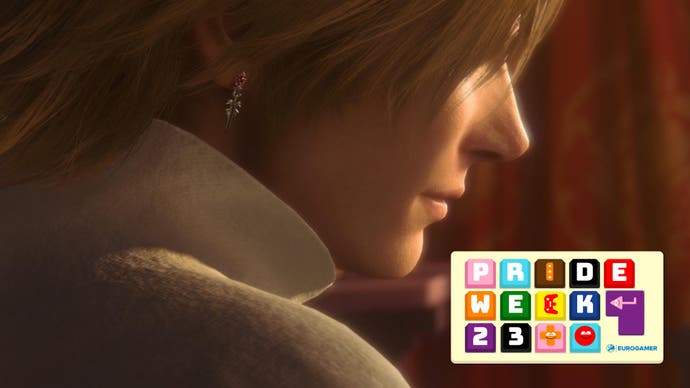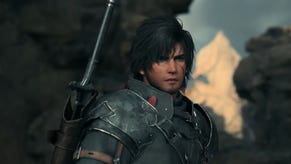Final Fantasy 16's moving LGBTQ+ representation proves the series is modernising
Gayme of Thrones.
This article contains spoilers for Final Fantasy 16.
"Is he...? Are they?! Yes!!"
I drop the controller, lift my arms into the air and let out a whoop. A gay kiss! In Final Fantasy!
It's not just any character either. It's Prince Dion Lesage, the Dominant of Bahamut. That's right folks, the king of dragons is gay.
It's all too rare to see LGBTQ+ representation in high profile AAA games. But to see it here, in a Final Fantasy game too, was such a moment of joy for me. It's why representation is so important: I feel seen and a part of this series I've loved for so long.
What I particularly love about Dion's sexuality is that it's just a brief moment. Dion and his attendant, Terence, share a quiet heart-to-heart inside his tent, discussing the intricacies of war with the neighbouring Dhalmeks - a conversation spurred by anxiety. Then they kiss, a tender moment among the bloodshed as they both consider what's at stake.
And then they move on. It's authentic, normalised. It's not sexual, but simply two characters sharing intimacy. Dion's sexuality is only referenced once more later on (as well as in a description of their relationship in the game's Active Time Lore feature) in a deeply affecting, tragic moment with little dialogue that's testament to the game's visuals and acting.
For the most part, Dion's sexuality is simply a part of his character that defies explanation. He simply is gay. It has no bearing on the plot, yet has huge ramifications for LGBTQ+ players.
(Not to mention, it's most likely the reason Final Fantasy 16 was banned in Saudi Arabia ahead of launch, with Square Enix showing "unwillingness to make the necessary modifications".)
Arguably, this could all be taken from the game's inspiration: Game of Thrones. Dion and Terence certainly have a Renly Baratheon and Loras Tyrell feel about them, the prince and his assistant engaged in a secret relationship. Whether Dion and Terence are similarly secretive is left ambiguous.
Yet there is other LGBTQ+ representation elsewhere in-game, mostly in incidental dialogue. There's a soldier in Northreach who tells his male lover his fears about the coming war, and, in one quest, Clive tells a pair of soldiers he's looking for a man. "Looking for a man? Does this look like a brothel, Branded?" one replies. I had to laugh. The soldier's response might be ignorantly homophobic, but it's proof of how present homosexuality is in Valisthea - and he's not exactly meant to be likeable.

Perhaps my surprise at the LGBTQ+ representation in Final Fantasy 16 is a disservice to Creative Business Unit 3. The Square Enix studio is known for its work on MMORPG Final Fantasy 14 - a game that doesn't include any explicitly LGBT+ lead characters, but that has a thriving queer community. Again, there's in-game incidental dialogue from minor characters, but there's also gay marriage between player characters. In-game Pride parades are a regular occurrence each year, while the studio collaborated on a float for Sydney's Mardi Gras Parade in 2019.
Still, the Final Fantasy series has something of a chequered history with LGBTQ+ representation. While fans have fancied FF13's Vanille and Fang as more than just friends (Fang, incidentally, was originally intended to be a male character), in addition to a whole host of fan fiction, FF7's cross-dressing scene is perhaps the most infamous example of questionable representation.
In Midgar, Cloud must infiltrate a mansion owned by mob boss Don Corneo. To do so, he's sent on a quest to collect various items of women's clothing, involving a trip to seedy brothel the Honeybee Inn. The quest is fuelled by uneasy stereotypes, Freddie Mercury lookalikes, and even an implied rape.

Yes, this was the mid-90s. But Square Enix rightfully updated the sequence for FF7 Remake, turning the Honeybee Inn into a gloriously queer celebration of the community through dance. It's now a nightclub attended by both men and women - in cute bee outfits - and we're introduced to new character Andrea Rhodea, who hosts fabulous Moulin Rouge-esque dance shows. "Stand up and bear your soul with pride," go the lyrics, before Andrea and Cloud dance together on-stage to funky disco music. "Keep it up Cloud, work it!" chimes in Aerith. Cloud's met with universal applause and players are awarded the Dancing Queen trophy.
"True beauty is an expression of the heart," says Andrea. "A thing without shame, to which notions of gender don't apply."
It's Final Fantasy at its most wonderfully camp and outlandish, though it's undermined by Cloud's shame afterwards at being dressed in feminine clothes. Yet this sequence is proof that Square Enix is willing to modernise. As the company seeks a global audience for its games, it will be judged by global standards - for better or worse - but in terms of LGBTQ+ representation, it's rising to the challenge. What's more, outside of Final Fantasy, last year's Harvestella was the first Square Enix game to include a non-binary gender option.
Dion and Terence's kiss is the first explicitly LGBTQ+ moment in the series' history. It might not have the campy showmanship of Andrea's dancing, but it's a more subtle and human moment that's arguably more powerful and affecting. Us gays might know how to throw a party, but we have the right to show love too.









